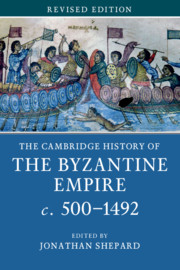Book contents
- The Cambridge History of the Byzantine Empire c. 500–1492
- Frontispiece
- The Cambridge History of the Byzantine Empire c. 500–1492
- Copyright page
- Contents
- Maps
- Illustrations
- Tables
- Dedication
- Preface
- Preface to the Paperback Edition
- General Introduction
- Part I The Earlier Empire c. 500–c. 700
- Part II The Middle Empire c. 700–1204
- Part III The Byzantine Lands in the Later Middle Ages 1204–1492
- Glossary (Including Some Proper Names)
- Genealogical Tables and Lists of Rulers
- Alternative Place Names
- Bibliography
- Book part
- Picture Acknowledgements
- Index
- References
Bibliography
Published online by Cambridge University Press: 04 November 2019
- The Cambridge History of the Byzantine Empire c. 500–1492
- Frontispiece
- The Cambridge History of the Byzantine Empire c. 500–1492
- Copyright page
- Contents
- Maps
- Illustrations
- Tables
- Dedication
- Preface
- Preface to the Paperback Edition
- General Introduction
- Part I The Earlier Empire c. 500–c. 700
- Part II The Middle Empire c. 700–1204
- Part III The Byzantine Lands in the Later Middle Ages 1204–1492
- Glossary (Including Some Proper Names)
- Genealogical Tables and Lists of Rulers
- Alternative Place Names
- Bibliography
- Book part
- Picture Acknowledgements
- Index
- References
- Type
- Chapter
- Information
- The Cambridge History of the Byzantine Empire c.500–1492 , pp. 936 - 1117Publisher: Cambridge University PressPrint publication year: 2019

